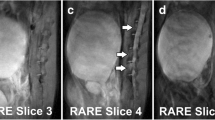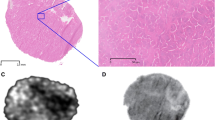Abstract
Purpose
We optimized acido-chemical exchange saturation transfer (acidoCEST) magnetic resonance imaging (MRI), a method that measures extracellular pH (pHe), and translated this method to the radiology clinic to evaluate tumor acidosis.
Procedures
A CEST-FISP MRI protocol was used to image a flank SKOV3 tumor model. Bloch fitting modified to include the direct estimation of pH was developed to generate parametric maps of tumor pHe in the SKOV3 tumor model, a patient with high-grade invasive ductal carcinoma, and a patient with metastatic ovarian cancer. The acidoCEST MRI results of the patient with metastatic ovarian cancer were compared with DCE MRI and histopathology.
Results
The pHe maps of a flank model showed pHe measurements between 6.4 and 7.4, which matched with the expected tumor pHe range from past acidoCEST MRI studies in flank tumors. In the patient with metastatic ovarian cancer, the average pHe value of three adjacent tumors was 6.58, and the most reliable pHe measurements were obtained from the right posterior tumor, which favorably compared with DCE MRI and histopathological results. The average pHe of the kidney showed an average pHe of 6.73 units. The patient with high-grade invasive ductal carcinoma failed to accumulate sufficient agent to generate pHe measurements.
Conclusions
Optimized acidoCEST MRI generated pHe measurements in a flank tumor model and could be translated to the clinic to assess a patient with metastatic ovarian cancer.





Similar content being viewed by others
References
Warburg O (1956) On the origin of cancer cells. Science 123:309–314
Chen LQ, Pagel MD (2015) Evaluating pH in the extracellular tumor microenvironment using CEST MRI and other imaging methods. Adv Radiol. doi:10.1155/2015/206405
Gatenby RA, Gawlinski ET, Gmitro AF et al (2006) Acid mediated tumor invasion: a multidisciplinary study. Cancer Res 66:5216–5223
Estrella V, Chen T, Lloyd M (2013) Acidity generated by the tumor microenvironment drives local invasion. Cancer Res 73:1524–1535
Akhenblit PA, Pagel MD (2016) Recent advances in targeting tumor energy metabolism with tumor acidosis as a biomarker of drug efficacy. J Cancer Sci Therapy 8:20–29
Chen LQ, Howison CM, Jeffery JJ (2013) Evaluations of extracellular pH within in vivo tumors using acidoCEST MRI. Magn Reson Med 72:1408–1417
Sheth VR, Li Y, Chen LQ (2012) Measuring in vivo tumor pHe with CEST-FISP MRI. Magn Reson Med 67:760–768
Liu G, Li Y, Sheth VR, Pagel MD (2012) Imaging in vivo extracellular pH with a single PARACEST MRI contrast agent. Mol Imaging 1:47–57
Sheth VR, Liu G, Li Y, Pagel MD (2012) Improved pH measurements with a single PARACEST MRI contrast agent. Contrast Media Mol Imaging 1:26–34
Aime S, Calabi L, Biondi L (2005) Iopamidol: exploring the potential use of a well-established x ray contrast agent for MRI. Magn Reson Med 53:830–834
Liepinsh E, Otting G (1996) Proton exchange rates from amino acid side chains—implications for image contrast. Magn Reson Med 1:30–42
Jones KM, Randtke ER, Howison CM et al (2015) Measuring extracellular pH in a lung fibrosis model with acidoCEST MRI. Mol Imaging and Biol 2:177–184
Woessner DE, Zhang S, Merritt MEG, Sherry AD (2005) Numerical solution of the Bloch equations provides insights into the optimum design of PARACEST agents for MRI. Magn Reson Med 53:790–799
Moon BF, Jones KM, Chen LQ et al (2015) A comparison of iopromide and iopamidol, two acidoCEST MRI contrast media that measure tumor extracellular pH. Contrast Media Mol Imaging 10:446–455
Hingorani DV, Montano LA, Randtke EA et al (2015) A single diamagnetic catalyCEST MRI contrast agent that detects cathepsin B enzyme activity by using a ratio of two CEST signals. Contrast Media Mol Imaging 11:130–138
Dopfert J, Zaiss M, Witte C, Schroeder L (2014) Ultrafast CEST imaging. J Magn Reson 243:47–53
Muller-Lutz A, Khalil N, Schmitt B et al (2014) Pilot study of iopamidol-based quantitative pH imaging on a clinical 3 T MR scanner. Magn Reson Mater Phy 27:477–485
Harston GWJ, Tee YK, Blockley N et al (2015) Identifying the ischaemic penumbra using pH-weighted magnetic resonance imaging. Brain A J Neurol 138:36-42
Ma B, Blakeley JO, Hong X et al (2016) Applying amide proton transfer-weighted MRI to distinguish pseudoprogression from true progression in malignant gliomas. J Magn Reson Imaging. doi:10.1002/jmri.2515
Author information
Authors and Affiliations
Corresponding author
Ethics declarations
Conflict of Interest
The authors declare that they have no conflict of interest.
Electronic Supplementary Material
ESM 1
(PDF 589 kb)
Rights and permissions
About this article
Cite this article
Jones, K.M., Randtke, E.A., Yoshimaru, E.S. et al. Clinical Translation of Tumor Acidosis Measurements with AcidoCEST MRI. Mol Imaging Biol 19, 617–625 (2017). https://doi.org/10.1007/s11307-016-1029-7
Published:
Issue Date:
DOI: https://doi.org/10.1007/s11307-016-1029-7




